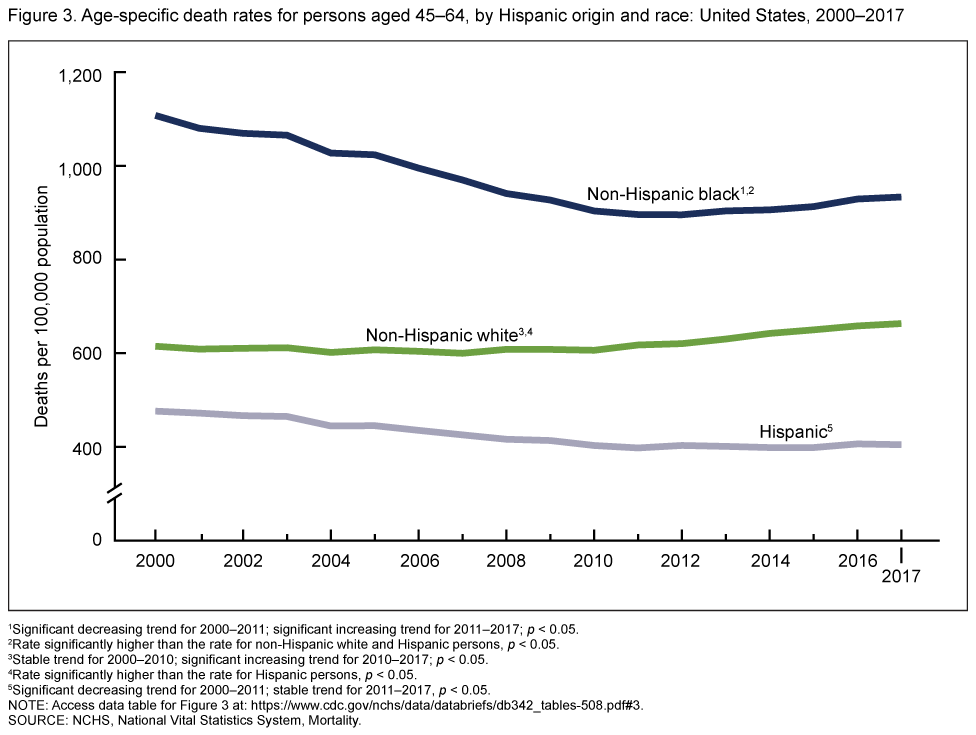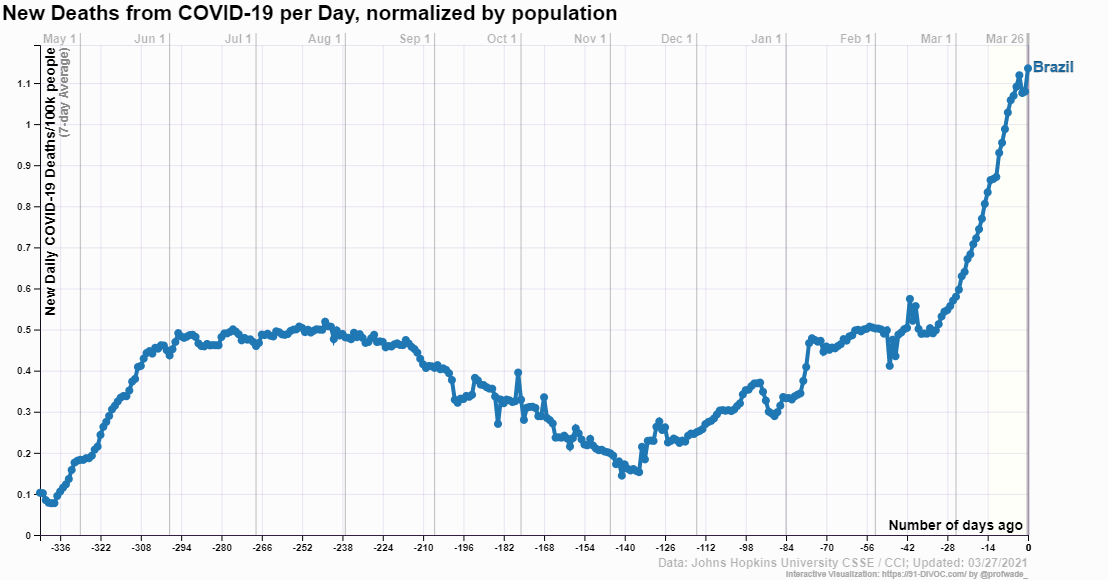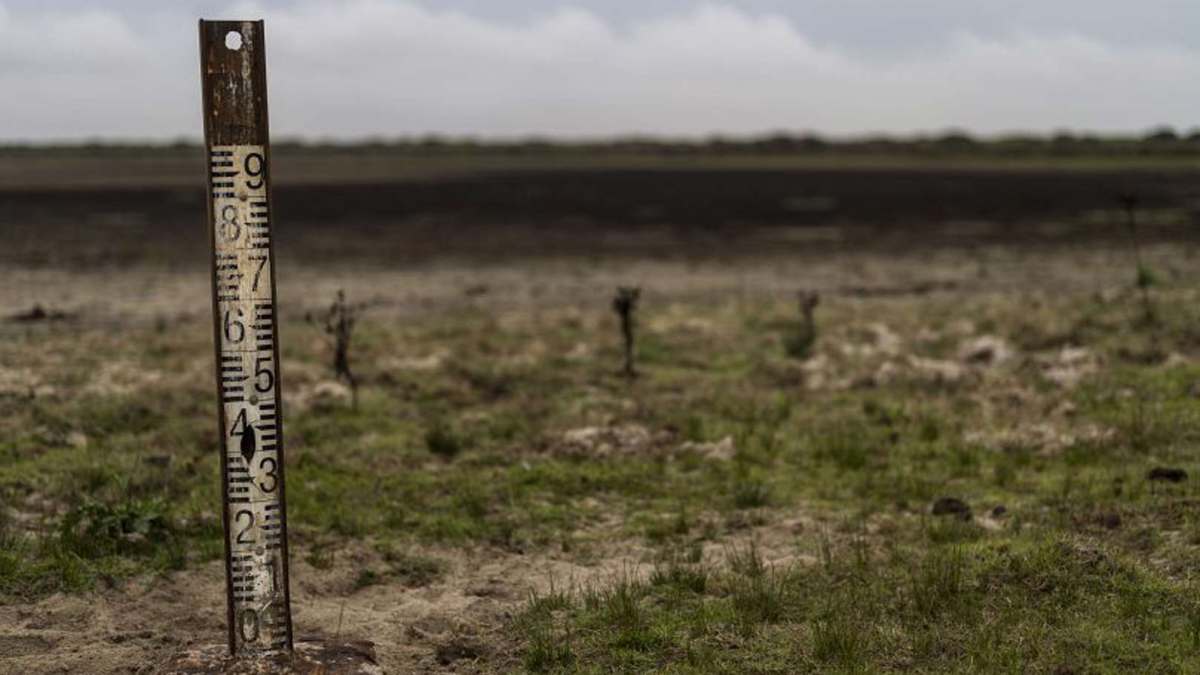Death rates increasing for U.S. adults aged 25 to 44: CDC report

24 July 2019 (ABC News) – Death rates are on the rise for young and middle-aged U.S. adults, with white and black people experiencing higher mortality than Hispanic people, according to new research from the Centers for Disease Control and Prevention (CDC) published Tuesday.
Between 2012 and 2017, the rates for white and black people aged 25 to 44 increased 21% each for both groups, while Hispanic people of the same age range saw a 13% rise.
Sally Curtin, a statistician at the CDC’s National Center for Health Statistics and one of the report’s authors, said an uptick in suicides, homicides and drug overdoses contributed to the higher rates for the younger part of the group.
Suicides in the United States saw a 19.2% increase in young adults aged 25 to 34 from 2012 to 2017, according to the American Foundation for Suicide Prevention. Homicides in the country increased from 2014 to 2016, though the rates were near historic lows, according to the Congressional Research Service.
Among those aged 25–44, all race and ethnicity groups experienced increases in death rates more recently, with greater percentage increases for non-Hispanic white and non-Hispanic black adults than for Hispanic adults.
Sally C. Curtin, M.A., and Elizabeth Arias, Ph.D., CDC
Drug overdoses declined by around 5% in 2018, the first drop since 1990, according to the provisional figures from the CDC published earlier this month. There were more than 702,000 deaths from drug overdoses between 1999 and 2017, 10% of which occurred in 2017, according to the agency.
Curtin noted that a rise in deaths due to heart disease was a factor in the higher number for the older portion of the 25-to-44 age group.
On a broader scale, the death rates among the three groups diverged. […]
For Hispanic adults between 45 and 64, death rates remained steady from 2011 through 2017 after declining from 2000 through 2011. However, rates for white and black adults aged 45 to 64 increased from 2010 to 2017, with a greater increase for white adults than for black adults. [more]
Death rates increasing for U.S. adults aged 25 to 44: CDC
Mortality trends by race and ethnicity among adults aged 25 and over: United States, 2000–2017
By Sally C. Curtin, M.A. and Elizabeth Arias, Ph.D.
24 July 2019
(CDC) – Hispanic adults in the United States have experienced lower overall mortality and consequently higher life expectancy than non-Hispanic white and non-Hispanic black adults. This report presents recent trends in age-adjusted death rates from 2000 through 2017 for adults aged 25 and over for Hispanic, non-Hispanic white, and non-Hispanic black adults, overall and by specific age groups (25–44, 45–64, and 65 and over). […]
For adults aged 25–44, death rates for all race and ethnicity groups declined from 2000 through 2012 and then increased through 2017.
Death rates for Hispanic, non-Hispanic white, and non-Hispanic black adults aged 25–44 all generally declined from 2000 through 2012 and then increased through 2017.
Between 2012 and 2017, death rates increased 21% among non-Hispanic white adults aged 25–44 (from 144.5 to 175.1), 21% for non-Hispanic black adults (from 206.8 to 234.7) and 13% for Hispanic adults (from 89.2 to 108.1).

Death rates for Hispanic adults aged 25–44 ranged between 54%–60% lower compared with non-Hispanic black adults, whereas the difference in death rates between Hispanic and non-Hispanic white adults aged 25–44 more than doubled, increasing from 17% to 38% lower for Hispanic adults between 2000 and 2017.
Death rates for non-Hispanic white adults aged 25–44 in 2000 were 50% lower compared with non-Hispanic black adults (140.6 compared with 282.7), and narrowed to 25% lower in 2017 (175.1 compared with 234.7).
For adults aged 45–64, death rates among non-Hispanic white and non-Hispanic black adults increased more recently, whereas the rate for Hispanic adults was stable from 2011 through 2017.
After remaining stable in the beginning of the period, death rates for adults aged 45–64 increased 9% among non-Hispanic white adults (from 606.3 in 2010 to 663.3 in 2017). After decreasing between 2000 and 2011, death rates among this age group increased 4% among non-Hispanic black adults (from 896.0 to 933.4) through 2017, whereas the rate for Hispanic adults was stable from 2011 through 2017 (Figure 3).
Between 2000 and 2017, death rates among Hispanic adults aged 45–64 ranged from 55% through 57% lower compared with non-Hispanic black adults, whereas the difference in death rates between Hispanic and non-Hispanic white adults aged 45–64 increased from 23% lower for Hispanic adults in 2000 to 39% lower in 2017.
Death rates for non-Hispanic white adults in 2000 were 44% lower compared with non-Hispanic black adults (614.9 compared with 1,107.5) and narrowed to 29% lower in 2017 (663.3 compared with 933.4). […]
Among those aged 25–44, all race and ethnicity groups experienced increases in death rates more recently, with greater percentage increases for non-Hispanic white and non-Hispanic black adults than for Hispanic adults. Trends for Hispanic adults aged 45–64 differed from trends for non-Hispanic white and black adults. After declining from 2000 through 2011, death rates for Hispanic adults aged 45–64 remained steady from 2011 through 2017. Rates for non-Hispanic white and non-Hispanic black adults increased recently, from 2010–2011 to 2017, with a greater percentage increase for non-Hispanic white adults than for non-Hispanic black and Hispanic adults. For adults aged 65 and over, all race and ethnicity groups showed general declines over the period, with non-Hispanic black adults experiencing the greatest percentage decline. [more]
Mortality Trends by Race and Ethnicity Among Adults Aged 25 and over: United States, 2000–2017


